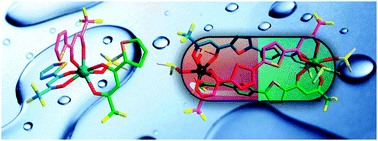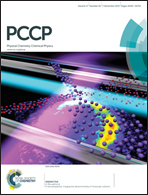Enhancement of near-infrared luminescence of ytterbium in triple-stranded binuclear helicates†
Abstract
A bis-β-diketone, bis(4,4,4-trifluoro-1,3-dioxobutyl)(2,2′-bithienyl) (BTT), which can be looked upon as coupling of two mono-β-diketones (2-thenoyltrifluoroacetone, TTA) at the 5,5′-position of thiophene ring, has been designed for exploring the advantages of binuclear helical structure in sensitizing the lanthanide NIR luminescence. The Yb(III) ion was selected as the luminescent center, and its corresponding mono-β-diketone complex Yb(TTA)3(DMSO) (1) and bis-β-diketone complex Yb2(BTT)3(DMSO)4 (2) were synthesized and isolated. X-ray crystallographical analysis reveals that the bis-β-diketone complex Yb2(BTT)3(DMSO)4 adopts a triple-stranded dinuclear structure, in which the two Yb(III) ions are helically wrapped by three ligands, and each Yb(III) ion is eight-coordinated by six oxygen atoms from three ligands and two oxygen atoms from the coordinated DMSO molecules. Whereas, the mono-β-diketone complex Yb(TTA)3(DMSO) is a mononuclear structure, the central Yb(III) ion is coordinated by seven oxygen atoms from three ligands and a DMSO molecule. The photophysical properties related to the electronic transition are characterized by the absorbance spectra, the emission spectra, the emission quantum yields, the emission lifetimes, and the radiative (kr) and nonradiative rate constants (knr). The luminescence quantum yield experiment reveals that the dinuclear complex has about 10 times luminescence enhancement compared with the mononuclear complex. This enhancement mainly benefits from its helical structure, which effectively depresses the nonradiative transition caused by high-energy oscillators in ligands, and the part-encapsulated structure decreases the probability of solvents entering the metal centers.


 Please wait while we load your content...
Please wait while we load your content...